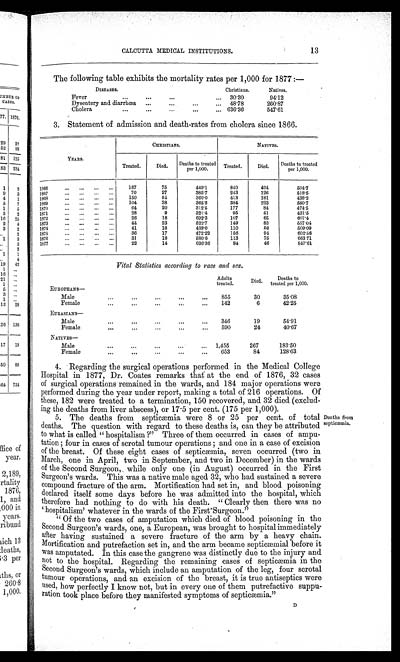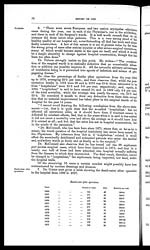Medicine - Institutions > Reports from medical colleges, schools and research institutions > Report on the Calcutta medical institutions > Calcutta medical institutions reports 1871-78 > Report on the Calcutta Medical Institutions for the year 1877
(598) Page 13
Download files
Individual page:
Thumbnail gallery: Grid view | List view

CALCUTTA MEDICAL INSTITUTIONS.
13
The following table exhibits the mortality rates per 1,000 for 1877:—
| DISEASES. | Christians. | Natives. | ||||
| Fever ... | ... | ... | ... | 30.30 | 94.12 | |
| Dysentery and diarrhœa | ... | ... | ... | ... | 48.78 | 260.87 |
| Cholera ... | ... | ... | ... | ... | 636.36 | 547.61 |
3. Statement of admission and death-rates from cholera since 1866.
| YEARS. | CHRISTIANS. | NATIVES. | ||||
| Treated. | Died. | Deaths to treated per 1,000. |
Treated. | Died. | Deaths to treated per 1,000. |
|
| 1866 ... ... ... ... | 167 | 75 | 449.1 | 840 | 424 | 504.7 |
| 1867 ... ... ... ... | 70 | 27 | 385.7 | 243 | 126 | 518.5 |
| 1868 ... ... ... ... | 150 | 54 | 360.0 | 413 | 181 | 438.2 |
| 1869 ... ... ... ... | 104 | 38 | 365.3 | 384 | 223 | 580.7 |
| 1870 ... ... ... ... | 64 | 20 | 312.5 | 177 | 84 | 474.5 |
| 1871 ... ... ... ... | 28 | 9 | 321.4 | 95 | 41 | 431.5 |
| 1872 ... ... ... ... | 26 | 18 | 692.3 | 107 | 65 | 607.4 |
| 1873 ... ... ... ... | 44 | 23 | 522.7 | 149 | 83 | 557.04 |
| 1874 ... ... ... ... | 41 | 18 | 439.0 | 110 | 56 | 509.09 |
| 1875 ... ... ... ... | 36 | 17 | 472.22 | 156 | 94 | 602.56 |
| 1876 ... ... ... ... | 31 | 18 | 580.6 | 113 | 75 | 663.71 |
| 1877 ... ... ... ... | 22 | 14 | 636.36 | 84 | 46 | 547.61 |
Vital Statistics according to race and sex.
| Adults treated. |
Died. | Deaths to treated per 1,000. |
||||||
| EUROPEANS— | ||||||||
| Male | ... | ... | ... | ... | ... | 855 | 30 | 35.08 |
| Female | ... | ... | ... | ... | ... | 142 | 6 | 42.25 |
| EURASIANS— | ||||||||
| Male | ... | ... | ... | ... | ... | 346 | 19 | 54.91 |
| Female | ... | ... | ... | ... | ... | 590 | 24 | 40.67 |
| NATIVES— | ||||||||
| Male | ... | ... | ... | ... | ... | 1,455 | 267 | 183.50 |
| Female | ... | ... | ... | ... | ... | 653 | 84 | 128.63 |
4. Regarding the surgical operations performed in the Medical College
Hospital in 1877, Dr. Coates remarks that at the end of 1876, 32 cases
of surgical operations remained in the wards, and 184 major operations were
performed during the year under report, making a total of 216 operations. Of
these, 182 were treated to a termination, 150 recovered, and 32 died (exclud-
ing the deaths from liver abscess), or 17.5 per cent. (175 per 1,000).
5.The deaths from septicæmia were 8 or 25 per cent. of total
deaths. The question with regard to these deaths is, can they be attributed
to what is called "hospitalism?" Three of them occurred in cases of ampu-
tation; four in cases of scrotal tumour operations; and one in a case of excision
of the breast. Of these eight cases of septicæmia, seven occurred (two in
March, one in April, two in September, and two in December) in the wards
of the Second Surgeon, while only one (in August) occurred in the First
Surgeon's wards. This was a native male aged 32, who had sustained a severe
compound fracture o f the arm. Mortification had set in, and blood poisoning
declared itself some days before he was admitted into the hospital, which
therefore had nothing to do with his death. "Clearly then there was no
'hospitalism' whatever in the wards of the First Surgeon."
Death from
septicæmia.
"Of the two cases of amputation which died of blood poisoning in the
Second Surgeon's wards, one, a European, was brought to hospital immediately
after having sustained a severe fracture of the arm by a heavy chain.
Mortification and putrefaction set in, and the arm became septicæmial before it
was amputated. In this case the gangrene was distinctly due to the injury and
not to the hospital. Regarding the remaining cases of septicæmia in the
Second Surgeon's wards, which include an amputation of the leg, four scrota
tumour operations, and an excision of the breast, it is true antiseptics were
used, how perfectly I know not, but in every one of them putrefactive suppu-
ration took place before they manifested symptoms of septicæmia."
D
Set display mode to: Large image | Zoom image | Transcription
Images and transcriptions on this page, including medium image downloads, may be used under the Creative Commons Attribution 4.0 International Licence unless otherwise stated. ![]()
| Permanent URL | https://digital.nls.uk/74974715 |
|---|
| Description | 13 titles. Describes research work and conditions, treatments, vaccine production, medical education, public health and disease outbreaks. Extensive tables show mortality rates and patient admissions. These - some from asylums, jails, dispensaries, civil and police hospitals – will be useful to epidemiologists. |
|---|




